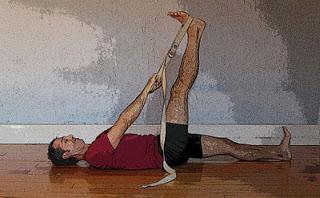 “I think it’s possible that we should not look at stretching so much as a way to make muscles longer, but instead view it as a way to make muscles stronger over a greater range of motion.” —James Speck
“I think it’s possible that we should not look at stretching so much as a way to make muscles longer, but instead view it as a way to make muscles stronger over a greater range of motion.” —James SpeckWe’ve all heard the cliché that yoga is “just stretching.” But anyone who has taken a few yoga classes knows better. All you have to do is try holding Downward-Facing Dog pose (Adho Mukha Svanasana) for a couple of minutes. Or Side Plank (Vasithasana). Or even Warrior 1 (Virbradrasana 1).One reason for this is that many of the yoga poses that you might think of as "stretching" also include weight-bearing and strength building as well, such as Triangle pose (Trikonasana) and Extended Hand to Toe pose (Utthita Hasta Padangusthasana). Think about it: even a simple stretching pose like Arms Overhead pose (Urdva Hastasana) is also strengthening your arms and upper body as raising arms above your head is resisting the pull of gravity. However, the yoga asana repertoire does include many poses that are more passive stretches, such as seated hip openers, seated forward bends, supported backbends, and reclined stretching poses. That's why years ago I was excited to learn from Baxter's post Friday Q&A: How to Stretch that even yoga's passive stretching poses (Reclined Leg Stretch, for example) are strengthening. Of course, I just had to look into it further because that's me for you—I always want to the why and the how as well as the what. And ultimately I found out that the way we typically think about "stretching" as a separate form of exercise from "strengthening" doesn't really make sense. In Stretching Is Really A Form of Strengthening, Physical therapist James Speck gives the following three reasons why stretching and strengthening can be considered the "same activity":
That's why years ago I was excited to learn from Baxter's post Friday Q&A: How to Stretch that even yoga's passive stretching poses (Reclined Leg Stretch, for example) are strengthening. Of course, I just had to look into it further because that's me for you—I always want to the why and the how as well as the what. And ultimately I found out that the way we typically think about "stretching" as a separate form of exercise from "strengthening" doesn't really make sense. In Stretching Is Really A Form of Strengthening, Physical therapist James Speck gives the following three reasons why stretching and strengthening can be considered the "same activity":
- "Similar active and passive tensile forces are present in both stretching and strengthening exercises
- The body’s response to stretching and strengthening is similar in terms of the mechanical activation of pathways that promote muscle growth
- Preliminary evidence suggests that regular stretching is able to promote muscle hypertrophy and muscular strength"
- result in muscle hypertrophy
- stimulate the expression of growth factors
- impart similar tensile forces on muscles
- lead to increased muscular strength
I should say, however, that if you are already very flexible, doing passive stretches, although they may feel very good to you, may not be the best way for you to practice. Hypermobile people can actually injure themselves by over-stretching (see Too much yoga? Or just the wrong kind? for information). But for the rest of us, using yoga as we age to maintain or improve our flexibility—the range of motion in our joints—is actually not "just" stretching, either. It's cultivating essential physical skill that contributes both to maintaining the ability to balance and the ability to stay agile, and it enables us to continue to do the activities we love, whether that means gardening, dancing, or playing with our favorite children. It's sure nice to know that when we're "stretching" we're also doing some strengthening at the same time, too!
Subscribe to Yoga for Healthy Aging by Email ° Follow Yoga for Healthy Aging on Facebook ° To order Yoga for Healthy Aging: A Guide to Lifelong Well-Being, go to Amazon, Shambhala, Indie Bound or your local bookstore.

